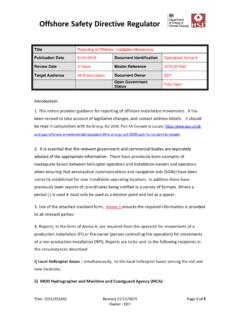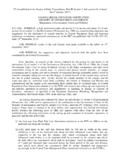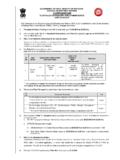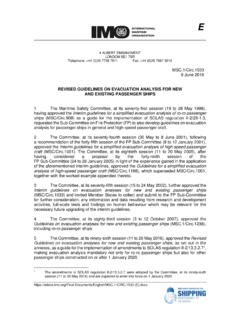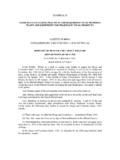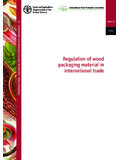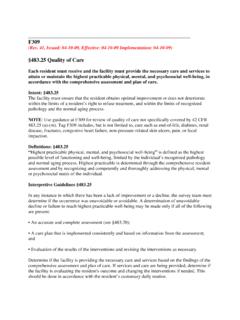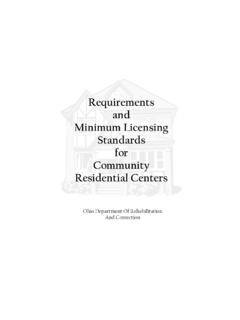Transcription of PRODUCT NAME: CARBONYL SULFIDE 1. Chemical …
1 MATERIAL SAFETY DATA SHEETPRODUCT NAME: CARBONYL SULFIDEMSDS: G-21 revised : 6/7/96 Page 1 of 61. Chemical PRODUCT and company IdentificationBOC Gases,Division ofThe BOC Group, Mountain AvenueMurray Hill, NJ 07974 TELEPHONE NUMBER: (908) 464-8100 BOC GasesDivision ofBOC Canada Limited5975 Falbourne Street, Unit 2 Mississauga, Ontario L5R 3W6 TELEPHONE NUMBER: (905) 501-170024-HOUR EMERGENCY TELEPHONE NUMBER:CHEMTREC (800) 424-930024-HOUR EMERGENCY TELEPHONE NUMBER:(905) 501-0802 EMERGENCY RESPONSE PLAN NO: 20101 PRODUCT NAME: CARBONYL SULFIDECHEMICAL NAME: CARBONYL SulfideCOMMON NAMES/SYNONYMS: Carbon Oxysulfide, Carbon Oxide SulfideTDG (Canada) CLASSIFICATION: ( )WHMIS CLASSIFICATION: A, B1, D1A, D2A, D2 BPREPARED BY.
2 Loss Control (908)464-8100/(905)501-1700 PREPARATION DATE: 6/1/95 REVIEW DATES: 6/7/962. Composition, Information on IngredientsINGREDIENT% VOLUMEPEL-OSHA1 TLV-ACGIH2LD50 or LC50 Route/SpeciesCarbonyl SulfideFORMULA: COSCAS: 463-58-1 RTECS #: AvailableNot AvailableLD5023 mg/kg(rat)1 As stated in 29 CFR 1910, Subpart Z ( revised July 1, 1993)2 As stated in the ACGIH 1994-95 Threshold Limit Values for Chemical Substances and Physical Agents3. Hazards IdentificationEMERGENCY OVERVIEWI rritating to the eyes, mucous membranes and respiratory system. Narcotic at high decompose into hydrogen SULFIDE within body tissues resulting in inhibition of cellular respiration,possible pulmonary paralysis, sudden collapse and death.
3 Highly OF ENTRY:Skin ContactYesSkin AbsorptionNoEye ContactYesInhalationYesIngestionNoPRODUC T NAME: CARBONYL SULFIDEMSDS: G-21 revised : 6/7/96 Page 2 of 6 HEALTH EFFECTS:Exposure LimitsNoIrritantYesSensitizationNoTerato genNoReproductive HazardNoMutagenNoSynergistic EffectsNone ReportedCarcinogenicity: -- NTP: No IARC: No OSHA: NoEYE EFFECTS:Low concentrations will generally cause irritation to the conjunctiva. Repeated exposure to low concentrationsis reported to cause conjunctivitis, photo phobia, corneal bullae, tearing, pain and blurred EFFECTS:May irritate the skin upon EFFECTS:Ingestion is EFFECTS:Irritating and a narcotic at high concentrations. May decompose into hydrogen SULFIDE within body SULFIDE reacts with enzymes in the bloodstream and inhibits cellular respiration resulting in pulmonaryparalysis, sudden collapse and death.
4 Continuous exposure to low (15-50 ppm) concentrations will generallycause irritation to mucous membranes, and may also cause headache, dizziness or nausea. Higher concentrations(200-300 ppm) may result in respiratory arrest leading to coma or unconsciousness. Exposures for more than 30minutes at concentrations greater than 700 ppm have been CONDITIONS AGGRAVATED BY EXPOSURE:Blood HAZARD CODESHMIS HAZARD CODESRATINGS SYSTEMH ealth: 3 Health: 30 = No HazardFlammability: 4 Flammability: 41 = Slight HazardReactivity: 1 Reactivity: 12 = Moderate Hazard3 = Serious Hazard4 = Severe Hazard4. First Aid MeasuresEYES:PERSONS WITH POTENTIAL EXPOSURE TO CARBONYL SULFIDE SHOULD NOT WEAR CONTACTLENSES.
5 Flush contaminated eyes with large amounts of water for at least 15 minutes. Part eyelids withfingers to ensure complete flushing. If irritation persists, seek medical attention :Flush affected area with water. If irritation persists, consult a :Treat in a manner similar to inhalation exposure. Seek medical attention as soon as : PRODUCT NAME: CARBONYL SULFIDEMSDS: G-21 revised : 6/7/96 Page 3 of 6 PROMPT MEDICAL ATTENTION IS MANDATORY IN ALL CASES OF OVEREXPOSURE. RESCUEPERSONNEL SHOULD BE EQUIPPED WITH SELF-CONTAINED BREATHING APPARATUS ANDSHOULD RECOGNIZE THE HAZARDS OF OVEREXPOSURE DUE TO OLFACTORY FATIGUE. Anextreme fire hazard exists when rescuing semiconscious or unconscious persons due to the flammability use of rescue equipment which may contain ignition sources or cause static discharge.
6 Victims should beassisted to an uncontaminated area and inhale fresh air. Quick removal from the contaminated area is mostimportant. If breathing has stopped administer artificial resuscitation and supplemental oxygen or a mixture of5% carbon dioxide in oxygen. Keep victim calm and warm. Further treatment should be symptomatic andsupportive. Seek medical assistance Fire Fighting MeasuresConditions of Flammability: FlammableFlash point:Not AvailableMethod:Not ApplicableAutoignitionTemperature: Not AvailableLEL(%): 12 UEL(%): 29 Hazardous combustion products: Sulfur CompoundsSensitivity to mechanical shock: NoneSensitivity to static discharge: NoneFIRE AND EXPLOSION HAZARDS: CARBONYL SULFIDE is heavier than air and may accumulate in low areas and may travel a considerable distance to asource of ignition.
7 Should flame be extinguished and flow of gas continue, increase ventilation to preventflammable mixture formation in low areas or pockets. PRODUCT may explode or burn over a wide range ofmixtures in MEDIA:Water, carbon dioxide, dry FIGHTING INSTRUCTIONS:If possible, stop the flow of CARBONYL SULFIDE . Use water spray to cool surrounding containers. Fire fightersshould use self-contained breathing Accidental Release MeasuresEvacuate all personnel from affected area. Use appropriate protective equipment. If leak is in user s equipment,be certain to purge piping with inert gas prior to attempting repairs. If leak is in container or container valve,contact the appropriate emergency telephone number listed in Section 1 or call your closest BOC Handling and StorageElectrical Classification:Class I, Group D.
8 Earth-ground and bond all lines and equipment associated with the CARBONYL SULFIDE electrical equipment should be non-sparking or explosion CARBONYL SULFIDE can be handled at normal temperatures with most metals. Moist CARBONYL sulfideshould be handled in aluminum alloys 25 and 35, 316 stainless steel or 18-8 chromium-nickel steels. Teflon ,Kel-F , Viton or Nylon are preferred gasket only in well-ventilated areas. Valve protection caps must remain in place unless container is secured withvalve outlet piped to use point. Do not drag, slide or roll cylinders. Use a suitable hand truck for cylindermovement. Use a pressure reducing regulator when connecting cylinder to lower pressure (<400 psig) piping orPRODUCT NAME: CARBONYL SULFIDEMSDS: G-21 revised : 6/7/96 Page 4 of 6systems.
9 Do not heat cylinder by any means to increase the discharge rate of PRODUCT from the cylinder. Use acheck valve or trap in the discharge line to prevent hazardous back flow into the cylinders from physical damage. Store in cool, dry, well-ventilated area away from heavily traffickedareas and emergency exits. Do not allow the temperature where cylinders are stored to exceed 130oF (54oC).Cylinders should be stored upright and firmly secured to prevent falling or being knocked over. Full and emptycylinders should be segregated. Use a "first in-first out" inventory system to prevent full cylinders being storedfor excessive periods of time. Post "NO SMOKING OR OPEN FLAMES" signs in the storage area or use should be no sources of ignition in the storage or use additional storage recommendations, consult Compressed Gas Association Pamphlet carry a compressed gas cylinder or a container of a gas in cryogenic liquid form in an enclosed space suchas a car trunk, van or station wagon.
10 A leak can result in a fire, explosion, asphyxiation or a toxic Exposure Controls, Personal ProtectionEXPOSURE LIMITS1:INGREDIENT% VOLUMEPEL-OSHA2 TLV-ACGIH3LD50 or LC50 Route/SpeciesCarbonyl SulfideFORMULA: COSCAS: 463-58-1 RTECS #: AvailableNot AvailableLD5023 mg/kg(rat)1 Refer to individual state of provincial regulations, as applicable, for limits which may be more stringent than those listed As stated in 29 CFR 1910, Subpart Z ( revised July 1, 1993)3 As stated in the ACGIH 1994-1995 Threshold Limit Values for Chemical Substances and Physical recommends a 10 ppm 8-hr TWA limit and a 15 ppm 15-minute STEL limit based on the ACGIH TLVand STEL limits for Hydrogen CONTROLS:Hood with forced ventilation.
